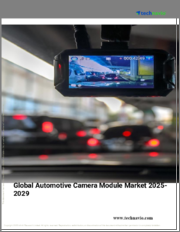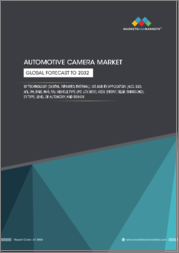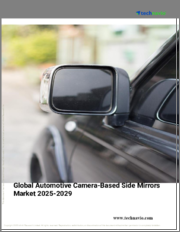
|
시장보고서
상품코드
1733758
세계의 차량용 카메라 시장 규모 : 차량 유형별, 카메라 유형별, 기술별, 용도별, 지역별, 예측Vehicle Camera Market Size by Vehicle Type, By Camera Type, By Technology, By Application, By Geographic Scope and Forecast |
||||||
차량용 카메라 시장 규모 및 전망
차량용 카메라 세계 시장 규모는 2024년에 96억 7,000만 달러로 평가되었고, 2026-2032년 12.30%의 연평균 복합 성장률(CAGR)로 성장하여 2032년에는 244억 5,000만 달러에 달할 것으로 예측됩니다.
차량용 카메라는 차량에 장착되어 주변을 실시간으로 촬영하는 디지털 기록 장치입니다. 안전성을 향상시키고 사고의 증거가 되며, 첨단운전자보조시스템(ADAS)와 자주 통합되어 내비게이션을 지원합니다.
차량용 카메라는 안전성을 향상시키고, 사고 처리, 주차, 운전자 행동 감시, 보험 청구 증거 제공, 도난 방지, 자율 주행 지원, 드라이브 여행의 추억 기록, 교통 위반 단속 지원 등에 도움이 됩니다.
차량용 카메라는 향후 자율주행 강화, 사고 기록, 실시간 교통 모니터링, 운전자 행동 분석, 증강현실 내비게이션, 도난 방지, 차량 간 통신, 보험금 청구 자동화, 차량 관리, 첨단운전자보조시스템(ADAS) 등에 적용될 예정입니다.
차량용 카메라 세계 시장 역학
세계 차량용 카메라 시장을 형성하는 주요 시장 역학은 다음과 같습니다.
주요 시장 성장 촉진요인:
첨단운전자보조시스템(ADAS) 수요 증가: 차량용 카메라는 차량의 안전성을 향상시키고, 주차, 차선 유지, 사고 방지 등 운전자를 지원하는 ADAS의 중요한 구성 요소입니다. 승용차와 상용차 모두 ADAS 기술의 사용이 증가하면서 차량용 카메라에 대한 수요가 증가하고 있습니다.
자율주행차의 부상: 자율주행차 및 반자율주행차의 개발과 도입은 차량용 카메라 산업을 크게 확장하고 있습니다. 이러한 차량은 내비게이션, 물체 감지 및 상황 인식 유지를 위해 카메라 시스템에 크게 의존하고 있습니다. 자동차 분야의 자동화가 진행됨에 따라 고급 카메라 시스템에 대한 수요는 증가할 것으로 예측됩니다.
기술 발전과 혁신 : 기술 발전과 혁신으로 차량용 카메라의 기능과 용도가 강화되고 있으며, AI 및 머신러닝과 같은 기술 혁신이 카메라 시스템에 통합되어 물체 인식 및 실시간 의사 결정을 개선하고 있습니다. 고해상도 촬영, 나이트 비전, 360도 뷰, 적외선 이미징 등 카메라 기술의 지속적인 개선.
주요 과제
최신 기술의 높은 비용: 고해상도 카메라, 나이트 비전, AI를 활용한 분석 등 최신 기술을 도입하면 차량용 카메라의 비용이 크게 상승할 수 있습니다. 이 때문에 특히 가격에 민감한 마켓플레이스나 개인 고객들 사이에서 보급이 제한될 수 있습니다.
프라이버시 및 보안 우려: 차량용 카메라, 특히 연속 녹화 기능이 있는 카메라의 사용은 프라이버시에 대한 심각한 우려를 불러일으킬 수 있습니다. 또한, 데이터 보안 및 녹화 영상의 악용 가능성도 문제이며, 규제 당국의 감시와 고객의 불안을 야기할 수 있습니다.
규제 및 컴플라이언스 문제: 차량용 카메라 사용에 대한 규제는 지역마다 다릅니다. 이러한 기준을 이해하는 것은 어렵고, 규정 준수 위반은 법적 처벌, 벌금, 시장 진입 제한으로 이어질 수 있습니다.
주요 동향 :
ADAS(첨단운전자지원시스템) 수요 증가: 차선 이탈 경고, 충돌 방지, 어댑티브 크루즈 컨트롤과 같은 ADAS 기능이 자동차에 탑재되면서 차량용 카메라에 대한 수요가 증가하고 있습니다. 이러한 시스템은 차량의 안전과 운전의 즐거움을 향상시키는 실시간 데이터를 제공하기 위해 주로 카메라에 의존하고 있습니다.
자동차 안전 규제 증가: 각국 정부의 엄격한 안전 요구 사항 및 표준으로 인해 자동차 제조업체는 차량용 카메라와 같은 안전 장비의 통합을 추진하고 있습니다. 사고 및 사망 사고를 방지하기 위해 규제 당국은 후방 카메라, 사각지대 감지 및 기타 안전 용도의 사용을 점진적으로 규제하고 있습니다.
대시 캠의 보급: 대시 캠은 소비자와 차량 소유자 모두에게 인기가 높아지고 있습니다. 블랙박스는 사고 발생 시 증거를 제공하고, 보험금 부정 청구를 억제하며, 전반적인 안전성을 향상시킬 수 있기 때문에 선호되고 있습니다. 차량 공유 서비스 및 상용차 관리 증가도 이러한 추세에 기여하고 있습니다.
목차
제1장 서론
- 시장의 정의
- 시장 세분화
- 조사 방법
제2장 주요 요약
- 주요 조사 결과
- 시장 개요
- 시장 하이라이트
제3장 시장 개요
- 시장 규모와 성장 가능성
- 시장 동향
- 시장 성장 촉진요인
- 시장 성장 억제요인
- 시장 기회
- Porter의 Five Forces 분석
제4장 차량용 카메라 시장 : 기술별
- 야간 투시 녹화
- GPS 내장
- 사고 센서
제5장 차량 카메라 시장 : 차량 유형별
- 상용차
- 승용차
제6장 차량용 카메라 시장 : 카메라 유형별
- Front View
- Rear View
- Interior Cam
제7장 차량용 카메라 시장 차량용 카메라 시장 : 용도별
- 정부 및 방위
- 자가용 차량
- 운송 차량
제8장 지역별 분석
- 북미
- 미국
- 캐나다
- 멕시코
- 유럽
- 영국
- 독일
- 프랑스
- 이탈리아
- 아시아태평양
- 중국
- 일본
- 인도
- 호주
- 라틴아메리카
- 브라질
- 아르헨티나
- 칠레
- 중동 및 아프리카
- 남아프리카공화국
- 사우디아라비아
- 아랍에미리트(UAE)
제9장 시장 역학
- 시장 성장 촉진요인
- 시장 성장 억제요인
- 시장 기회
- COVID-19의 시장에 대한 영향
제10장 경쟁 구도
- 주요 기업
- 시장 점유율 분석
제11장 기업 개요
- Sony Corporation
- Omnivision Technologies Limited
- Samsung Electronics Co., Ltd
- Aptina Imaging Corporation
- NXP Semiconductors N.V.
- STMicroelectronics International NV
- Texas Instruments Incorporated
- Infineon Technologies AG
- Continental AG
- Robert Bosch GmbH
- Valeo S.A.
- Denso Corporation
- Delphi Automotive PLC
- Magna International Inc.
- Lear Corporation
- Mobileye N.V.
- Brigade Electronics, Inc.
- Cohda Wireless Limited
- Waymo LLC(formerly Google Self-Driving Car)
- Baidu Apollo
제12장 시장 전망 시장 전망과 기회
- 신기술
- 향후 시장 동향
- 투자 기회
제13장 부록
- 약어 리스트
- 출전 및 참고문헌
Vehicle Camera Market Size And Forecast
Global Vehicle Camera Market size was valued at USD 9.67 Billion in 2024 and is projected to reach 24.45 USD Billion by 2032 growing at a CAGR of 12.30% from 2026 to 2032.
A vehicle camera is a digital recording device put in vehicles that captures real-time footage of their surroundings. It improves safety gives evidence in accidents and helps with navigation frequently integrating with advanced driver assistance systems.
Vehicle cameras improve safety and help with accident paperwork, parking, monitoring driver behavior, providing evidence for insurance claims, deterring theft, supporting autonomous driving, capturing road trip memories and assisting law enforcement with traffic infractions.
Vehicle cameras will be applied in the future for enhanced autonomous driving, accident documentation, real-time traffic monitoring, driver behavior analysis, augmented reality navigation, theft prevention, vehicle-to-vehicle communication, insurance claim automation, fleet management, and advanced driver assistance systems (ADAS).
Global Vehicle Camera Market Dynamics
The key market dynamics that are shaping the global vehicle camera market include:
Key Market Drivers:
Rising Demand for Advanced Driver Assistance Systems (ADAS): Vehicle cameras are critical components of ADAS, as they improve vehicle safety and help drivers with duties like parking, lane keeping, and accident avoidance. The rising use of ADAS technologies in both passenger and commercial cars is driving up demand for vehicle cameras.
The Rise of Autonomous Vehicles: The development and implementation of self-driving and semi-autonomous vehicles are greatly expanding the vehicle camera industry. These vehicles rely largely on camera systems to navigate, detect objects and maintain situational awareness. As the automotive sector becomes more automated, the demand for sophisticated camera systems is projected to increase.
Technological Advancements and Innovations: Technological advancements and innovations are enhancing the capabilities and applications of vehicle cameras. Innovations like AI and machine learning are also being integrated into camera systems to improve object recognition and real-time decision-making. Continuous improvements in camera technologies, such as high-resolution photography, night vision, 360-degree views and infrared imaging.
Key Challenges:
High Cost of Modern Technologies: The incorporation of modern technologies like as high-definition cameras, night vision and AI-powered analytics can drastically raise the cost of car cameras. This may limit their uptake, particularly in price-sensitive marketplaces and among individual customers.
Privacy and Security Concerns: The usage of vehicle cameras, especially those with continuous recording capabilities, presents serious privacy concerns. There are also issues about data security and the potential exploitation of recorded footage, which can result in regulatory scrutiny and customer apprehension.
Regulatory and compliance issues: Regulations governing the usage of car cameras differ by area. Navigating these standards can be difficult, and noncompliance can result in legal consequences, fines and restrictions on market entrance.
Key Trends:
Rising Demand for Advanced Driver Assistance Systems (ADAS): The inclusion of ADAS functions in automobiles, such as lane departure warning, collision avoidance, and adaptive cruise control is increasing demand for vehicle cameras. These systems rely primarily on cameras to provide real-time data that improves vehicle safety and driving enjoyment.
Increase in Automotive Safety Regulations: Stringent safety requirements and standards enforced by governments throughout the world are pushing automakers to integrate more safety equipment, such as car cameras. To prevent accidents and fatalities, regulators are progressively regulating the use of cameras for reversing, blind-spot detection and other safety applications.
Rising Adoption of Dash Cams: Dash cams are becoming increasingly popular among both consumers and fleet owners. Dash cameras are desirable because they can give evidence. in case of accidents, deter fraudulent insurance claims, and enhance overall security. The rise in ride-sharing services and commercial fleet management is also contributing to this trend.
Global Vehicle Camera Market Regional Analysis
Here is a more detailed regional analysis of the global vehicle camera market:
North America:
According to Verified Market Research, North America is expected to dominate the global vehicle camera market.
North America dominates the vehicle camera market owing to its advanced automotive sector and strict safety standards. Consumer desire for improved safety features is driving the region's high adoption rate of advanced driver assistance systems (ADAS) and other vehicle safety technology.
New automobiles must comply with stringent government laws and requirements, which include the installation of safety equipment like vehicle cameras.
Also, the existence of important market competitors and constant technological improvements in camera systems help to maintain market leadership. Dash cams' growing popularity among individual consumers and fleet operators is boosting the market in North America.
Asia Pacific:
According to Verified Market Research, Asia Pacific is fastest growing region in global vehicle camera market.
Rapid urbanization and rising disposable incomes are driving up sales of automobiles and creating a larger demand for vehicle safety features.
Governments in China, India and Japan are enforcing stronger safety standards, encouraging the use of advanced driver assistance systems (ADAS) and car cameras. The region's thriving car manufacturing industry also contributes to market expansion.
Furthermore, rising customer awareness of car safety, combined with developments in camera technology is moving the market forward making Asia-Pacific a vital region of emphasis for industry participants.
Global Vehicle Camera Market: Segmentation Analysis
The Global Vehicle Camera Market is segmented based on Vehicle Type, Camera Type, Technology, Application and Geography.
Global Vehicle Camera Market, By Vehicle Type
- Commercial Vehicle
- Passenger Vehicle
Based on Vehicle Type, the Global Vehicle Camera Market is separated into Commercial Vehicle and Passenger Vehicle. Passenger vehicles is expected to lead the worldwide vehicle camera market owing to the consumers are more likely to accept modern safety systems such as ADAS. Passenger vehicles frequently incorporate numerous cameras for tasks such as parking assistance, lane departure warning and collision avoidance systems. The growing emphasis on driver and passenger safety in passenger vehicles worldwide contributes greatly to their dominance in the vehicle camera industry.
Global Vehicle Camera Market, By Camera Type
- Front View
- Rear View
- Interior Cam
Based on Camera Type, Global Vehicle Camera Market is divided into Front View, Rear View Interior Cam. Rear view cameras dominate the global vehicle camera market because they are widely used to improve vehicle safety and agility, as mandated by regulations in many places. These cameras help with parking and reversing, decreasing accidents and increasing driver visibility. Front and interior cameras perform important roles, but they are often second to rear view cameras in terms of market share and regulatory focus.
Global Vehicle Camera Market, By Technology
- Night Vision Recording
- Built-in GPS
- Accident Sensor
Based on Technology, Global Vehicle Camera Market is divided into Night Vision Recording, Built-in GPS and Accident Sensor. In the global vehicle camera market, night vision recording technology is dominant. It improves vision in low-light circumstances, hence increasing driver safety and preventing accidents. Night vision capabilities are rapidly being integrated into vehicle cameras to give crisp image at night or in inclement weather, solving essential safety concerns while promoting market adoption of this advanced technology.
Global Vehicle Camera Market, By Application
- Government and Defense
- Private Vehicles
- Transportation Vehicles
Based on Application, Global Vehicle Camera Market is divided into Government and Defense, Private Vehicles and Transportation Vehicles. Private vehicles dominate the worldwide automotive camera market as dash cameras are widely used for safety and security. Private vehicle owners utilize cameras to provide proof in accidents and insurance claims. The government and defense industries also make substantial contributions, using cameras for surveillance, law enforcement and military applications, motivated by security concerns and regulatory requirements for improved monitoring capabilities.
Global Vehicle Camera Market, By Geography
- North America
- Europe
- Asia Pacific
- Rest of the world
Based on the Geography, the Global Vehicle Camera Market divided into North America, Europe, Asia Pacific and Rest of the World. North America leads the worldwide vehicle camera market due to strict safety standards and widespread usage of advanced driver assistance systems (ADAS). Meanwhile, Asia Pacific emerges as the fastest-growing area propelled by rising vehicle production, increased safety awareness, and quick adoption of ADAS technologies in emerging economies. Europe follows closely, with a thriving automotive sector and strong regulatory support for vehicle safety technology.
Key Players
- The Global Vehicle Camera Market study report will provide valuable insight with an emphasis on the global market. The major players in the market are Continental AG, Robert Bosch GmbH, Valeo SA, Aptiv PLC, Denso Corporation, Sony Group Corporation, Samsung Electronics Co., Ltd., OmniVision Technologies, Inc., STMicroelectronics NV.
Our market analysis also entails a section solely dedicated to such major players wherein our analysts provide an insight into the financial statements of all the major players, along with product benchmarking and SWOT analysis. The competitive landscape section also includes key development strategies, market share, and market ranking analysis of the above-mentioned players globally.
- Global Vehicle Camera Market Recent Developments
- In January 2023, Nexar, Inc., a dash cam manufacturer, introduced the Pro GPS twin dash camera Max. It features high-quality 1080p full-HD picture sensors. The footage is clean and clear. Vehicle features, including number plates and faces, are plainly discernible. This type of camera will now be chosen in the market above other low-cost quality cameras
- In January 2023, Amazon.com Inc, Amazon's Ring division, will launch its first automobile dashboard camera. Ring Car Cam records both inside and outside of the vehicle. The product uses sensors to detect both internal and external disturbances, such as collisions or break-ins.
- Analyst's Take
- The vehicle camera market is poised for substantial growth in the forecast period, driven by several key factors. Firstly, the increasing emphasis on road safety and regulatory mandates mandating the installation of safety equipment in vehicles is a significant driver. Additionally, the rising consumer awareness regarding the benefits of vehicle cameras in reducing accidents, preventing theft, and providing evidence in insurance claims is fueling market demand.
- Moreover, technological advancements such as the integration of artificial intelligence (AI) for advanced features like lane departure warning, collision avoidance, and driver monitoring systems are further propelling market growth. Furthermore, the growing adoption of electric vehicles (EVs) and autonomous vehicles (AVs) is creating additional opportunities for the vehicle camera market, as these vehicles require advanced sensing and monitoring systems for safe operation.
- Geographically, North America and Europe are expected to dominate the vehicle camera market due to stringent safety regulations and the presence of key automotive manufacturers investing in advanced safety technologies. However, the Asia-Pacific region is anticipated to witness significant growth owing to the rapid urbanization, increasing vehicle sales, and rising disposable income levels in emerging economies like China and India.
- In conclusion, the vehicle camera market is set for robust growth driven by increasing safety concerns, technological advancements, and expanding automotive production and sales globally. However, market players need to focus on innovation, product differentiation, and strategic partnerships to maintain a competitive edge in this evolving landscape.
TABLE OF CONTENTS
1. Introduction
- Market Definition
- Market Segmentation
- Research Methodology
2. Executive Summary
- Key Findings
- Market Overview
- Market Highlights
3. Market Overview
- Market Size and Growth Potential
- Market Trends
- Market Drivers
- Market Restraints
- Market Opportunities
- Porter's Five Forces Analysis
4. Vehicle Camera Market, By Technology
- Night Vision Recording
- Built-in GPS
- Accident Sensor
5. Vehicle Camera Market, By Vehicle Type
- Commercial Vehicle
- Passenger Vehicle
6. Vehicle Camera Market, By Camera Type
- Front View
- Rear View
- Interior Cam
7. Vehicle Camera Market, By Application
- Government and Defense
- Private Vehicles
- Transportation Vehicles
8. Regional Analysis
- North America
- United States
- Canada
- Mexico
- Europe
- United Kingdom
- Germany
- France
- Italy
- Asia-Pacific
- China
- Japan
- India
- Australia
- Latin America
- Brazil
- Argentina
- Chile
- Middle East and Africa
- South Africa
- Saudi Arabia
- UAE
9. Market Dynamics
- Market Drivers
- Market Restraints
- Market Opportunities
- Impact of COVID-19 on the Market
10. Competitive Landscape
- Key Players
- Market Share Analysis
11. Company Profiles
- Sony Corporation
- Omnivision Technologies Limited
- Samsung Electronics Co., Ltd
- Aptina Imaging Corporation
- NXP Semiconductors N.V.
- STMicroelectronics International NV
- Texas Instruments Incorporated
- Infineon Technologies AG
- Continental AG
- Robert Bosch GmbH
- Valeo S.A.
- Denso Corporation
- Delphi Automotive PLC
- Magna International Inc.
- Lear Corporation
- Mobileye N.V.
- Brigade Electronics, Inc.
- Cohda Wireless Limited
- Waymo LLC (formerly Google Self-Driving Car)
- Baidu Apollo
12. Market Outlook and Opportunities
- Emerging Technologies
- Future Market Trends
- Investment Opportunities
13. Appendix
- List of Abbreviations
- Sources and References



















